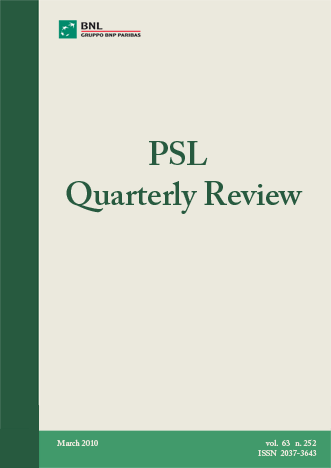Can a return to Glass-Steagall provide financial stability in the US financial system?
DOI:
https://doi.org/10.13133/2037-3643/9436Keywords:
Financial Crisis, Instability, Rules, Banking SystemAbstract
In the immediate aftermath of the current financial crisis in the United States the response has been to resolve small and medium size banks, while large banks experiencing financial trouble have been given both direct and indirect government support. This, however, has resulted in a number of larger banks absorbing smaller ones, creating an even smaller number of even larger banks that dominate the financial system. This article deals first with a comparison of the problems created by “too big to fail” financial institutions. The second section deals with the possible restoration of Glass-Steagall type legislation as a means of restoring single-function financial institutions. It concludes that alternatives to separation of functions will have to be found to deal with multifunction financial institutions since most lending activity requires securities markets activities.
JEL Codes: E50, G01, G20, F30, N22
References
A.G. BECKER INC. v. BOARD OF GOVERNORS OF THE FEDERAL RESERVE SYSTEM, 693 F.2d 136 (D.C. Cir. 1982).
ARENSON K. W. (1979), “Can Morgan Stanley Cling to Sole Managing?”, The New York Times, October 8.
BRANDEIS L. D. (1914), Other People’s Money and How the Bankers Use It, New York: Frederick A. Stokes Company.
EDWARDS GEORGE W. (1938), The Evolution of Finance Capitalism, London: Longmans, Green and Co.
DEPARTMENT OF THE TREASURY (2008), Blueprint for a Modernized Financial Regulatory Structure, March.
FEDERAL DEPOSIT INSURANCE CORPORATION (FDIC) (1984), The First Fifty Years: A History of the FDIC, 1933-1983, Washington, D.C.: FDIC.
FEDERAL RESERVE BOARD (FRB) (1933), “Banking Act of 1933”, Federal Reserve Bulletin, vol. 19 n. 6,pp. 385-401.
FELDKAMP F. L. (2009), “Crises and Recoveries, 1987-2009: Myths, Rumors and Possible Truths”, Institutional Risk Analytics, September 1, www.institutionalriskanalytics.com/pdf/Article%209-1-09%20%282%29.pdf.
FERGUSON T. (1984), “From Normalcy to New Deal: Industrial Structure, Party Competition, and American Public Policy in the Great Depression”, International Organization, vol. 38 n. 1, pp. 41-49.
FISHER K. R. (2001), “Orphan of Invention: Why the Gramm-Leach-Bliley Act Was Unnecessary”, Oregon Law Review, vol. 80 n. 4, pp. 1301-422.
GORTON G. B. (2009), “Slapped in the Face by the Invisible Hand: Banking and the Panic of 2007”, Social Science Research Network, May 9.
JOHNSON A. M. (1968), Winthrop W. Aldrich, Lawyer, Banker, Diplomat, Boston: Harvard University, Graduate School of Business Administration.
KAUFMAN G. G. (1988), “Securities Activities of Commercial Banks: Recent Changes in the Economic and Legal Environments”, Journal of Financial Services Research, vol. 1 n. 2, pp. 183-99.
KEYNES J. M. (1936), The General Theory of Employment, Interest and Money, London: Macmillan.
KLEBANER B. J. (1974), Commercial Banking in the United States: A History, Hinsdale, Illinois: Dryden Press.
KROOSS H. E. ed. (1969), Documentary History of Banking and Currency in the United States. 4 vols., New York: Chelsea House Publishers.
MAYER M. (1997), The Bankers, The Next Generation, New York: Truman Talley Books/Plume.
MINSKY H. P. (1957), “Central Banking and Money Market Changes”, The Quarterly Journal of Economics, vol. 71 n. 2, pp. 171-87.
MINSKY H. P. (2008) [1986], Stabilizing an Unstable Economy, New edition, New York: McGraw-Hill.
MINSKY H. P. (2008), “Securitization”, Policy Note 2008/2, Annandale-on-Hudson, NewYork: Levy Economics Institute of Bard College.
NORTON R. E. (1986), “Unleashing Banks on Wall Street”, Fortune, September 29.
OMAROVA S. T. (2009), “The Quiet Metamorphosis: How Derivatives Changed the ‘Business of Banking’”, University of Miami Law Review, vol. 63 n. 4, pp. 1041-110.
PEKAREK E. and M. HUTH (2008), “Bank Merger Reform Takes an Extended Philadelphia National Bank Holiday”, Fordham Journal of Corporate and Financial Law, vol. 13 n. 4, pp. 595-703.
PRINS N. (2004), Other People’s Money: The Corporate Mugging of America, New York: The New Press.
RANIERI L. S. (1996), “The Origins of Securitization, Sources of Its Growth, and Its Future Potential”, pp. 31-43 in L. T. Kendall and M. J. Fishman (eds.), A Primer on Securitization, Cambridge, Mass: The MIT Press.
ROBINSON R. I. (1941), “Commercial Bank Operations”, pp. 169-88 in Banking Studies by Members of the Staff, Board of Governors of the Federal Reserve System, Baltimore: The Waverly Press.
SCOTT K. E. (1981), “The Uncertain Course of Bank Deregulation”, Regulation: AEI Journal on Government and Society, vol. 5 n. 3, pp. 40-45.
SECURITIES INDUSTRY ASSOCIATION v. BOARD OF GOVERNORS OF THE FEDERAL RESERVE SYSTEM (et al.) (1984), 468 U.S. 207, 104 S. Ct. 3003, 82 L.Ed.2d 158.
SHULL B. and HANWECK G. A. (2001), Bank Mergers in a Deregulated Environment: Promise and Peril, Westport, Conn.: Quorum Books.
SICLARI V. (2001), “A Tough Act to Follow: How to Deal with the Investment Company Act of 1940”, Business Law Today, vol. 10 n. 3, p. 43 ff.
SIMONS H. C. 1948 (1934), “A Positive Program for Laissez- Faire”, in H. C. Simons, Economic Policy for a Free Society, Chicago: University of Chicago Press.
STIGUM M. (1978), The Money Market: Myth, Reality, and Practice, Homewood, Illinois: Dow Jones-Irwin. Time.
STIGUM M. (1932) “National Affairs: Glass Bill”, February 8.
STIGUM M. (1932), “National Affairs: New Glass Bill”, April 25.
WILLIS H. P. (1921), American Banking, Rev. ed. Chicago: La Salle Extension University.
WYATT W. (1941), “Federal Banking Legislation”, in Banking Studies by Members of the Staff, Board of Governors of the Federal Reserve System, pp. 39-64, Baltimore: The Waverly Press.
SOLOMON S. (1995), The Confidence Game: How Unelected Central Bankers Are Governing the Changed Global Economy, New York: Simon & Schuster.
Downloads
Published
How to Cite
Issue
Section
License



